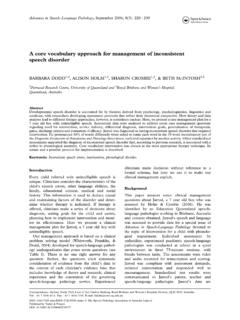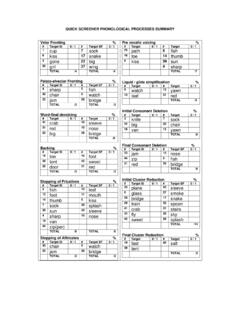Transcription of Caroline Bowen - Speech-Language Therapy
1 speech Sound Disorders 101 PART 5 Caroline Bowen Controversial non- evidence based Practices Readings Hodge, M. M. (2015). What can we learn about clinical prac?ce from SLP experience using NS- OME in children s speech Therapy ? In C. Bowen , Children's speech sound disorders (2nd ed.). Oxford: Wiley- Blackwell, pp. 232- 6. Lof, G. L. (2015). The NS- OME phenomenon in speech pathology prac?ce. In C. Bowen , Children's speech sound disorders (2nd ed.). Oxford: Wiley- Blackwell, pp. 252- 7. Powell, T. W. (2015). NS- OME: an ethical challenge. In C. Bowen , Children's speech sound disorders (2nd ed.). Oxford: Wiley- Blackwell, pp. 271- 4. Copyright 2015 Caroline Bowen Non- speech Oral Motor Exercises are used by some Speech-Language Pathologists / speech and Language Therapists because they believe, despite evidence to the contrary, that these exercises will facilitate speech development, or improve a client s speech 2015 Caroline Bowen People ask, 'Which method do you use for SSD?
2 ' There is a range of treatment approaches and a range of commercially available materials and programs for speech sound disorders. Not all treatments are suitable for every child. All treatments must be individually tailored. In that sense there is no best method . A good method is one that is adaptable to changes in the child, and flexible over time, and across settings, and across Copyright 2015 Caroline Bowen Copyright 2015 Caroline Bowen ..and is 'scientific' Copyright 2015 Caroline Bowen 'I want ___ s Therapy to be based on the best science.' Copyright 2015 Caroline Bowen Oral-motor exercises are activities that involve sensory stimulation to or actions of the lips, jaw, tongue, soft palate, larynx, and respiratory muscles which are intended to influence the physiologic underpinnings of the oropharyngeal mechanism and thus improve its functions; oral-motor exercises may include active muscle exercise, muscle stretching, passive exercise and sensory stimulation.
3 Arvedson, J., Clark, H., Frymark, T., Lazarus, C., Lof, G., McCauley, R., Mullen, R., Schooling, T., & Strand, E. (2007, November). The effec?veness of oral- motor exercises: An evidence - based systema?c review. Paper presented at the annual conven?on of the American speech - Language- Hearing Associa?on, Boston. Common abbreviations OMT Oral Motor Therapy OME Oral Motor Exercises NS-OMT Non- speech Oral Motor Therapy NS-OME Non- speech Oral Motor Exercises NSOMTs Non- speech Oral Motor Treatments Other terms Oro-motor work Oral placement Therapy / TalkTools Copyright 2015 Caroline Bowen What it s not! Phonemic placement techniques butterfly position tongue-up-tongue-down for /l/ straws to direct airflow for lateral /s/ use of bite blocks to achieve place etc.
4 Copyright 2015 Caroline Bowen People ask, 'Why don t you use Oral Motor Therapy ?' There is no evidence to support their use of, and there is no theory to suggest that the evidence might be forthcoming eventually , according to: Systematic Reviews in 2007 and 2015 Arvedson, J., Clark, H., Frymark, T., Lazarus, C., Lof, G., McCauley, R., Mullen, R., Schooling, T., & Strand, E. (2007). Lee, A. S- Y., & Gibbon, F. E. (2015). 'Non- speech oral motor treatment for developmental speech sound disorders in children'. Cochrane Database of Systema=c Reviews. Two Clinical Forums in 2008 1. Language speech & Hearing Services in Schools 2. Seminars in speech & Language Copyright 2015 Caroline Bowen I don t use them, but 85% of US and 85% of Albertan SLPs use NS- OMEs: 1.
5 To increase articulator strength and coordination 2. to facilitate stimulability 3. to improve intelligibility Lof & Watson, 2008 Hodge, Salonka, & Kollias, 2005 Copyright 2015 Caroline Bowen They are used by many SLPs/SLTs around the world in order: Copyright 2015 Caroline Bowen 1. To increase the range, accuracy, strength and speed of oral movements. 2. To develop voluntary control of oral movements. 3. To develop awareness of oral structures. 4. To develop motor programs underlying specific features of speech sounds. 5. To stimulate speech & language development 6. To provide a non-threatening way in to Therapy for children wary of direct speech work. Copyright 2015 Caroline Bowen IE CA US MY PH PT SG HK NZ AU UK ZA Caroline ID DK Copyright 2015 Caroline Bowen So there is lots and lots of sucking chewing blowing biMng s t r e t c h I n g Mckling and vibraMng going on wherever SLPs/SLTs purport to work on speech .
6 Copyright 2015 Caroline Bowen sucking chewing blowing biMng stretching Mckling and vibraMng Why? Copyright 2015 Caroline Bowen sucking chewing blowing biMng stretching Mckling and vibraMng What is the evidence ? Levels of evidence Level Description Ia Meta-analysis of >1 RCT Ib Randomised controlled study IIa Controlled study without randomisation IIb Quasi-experimental study III Non-experimental studies: correlational and case studies IV Expert committee report, consensus conference, clinical experience of respected authorities Copyright 2015 Caroline Bowen ASHA 2004 Copyright 2015 Caroline Bowen Level Description (ASHA, 2004) Ia Meta-analysis of >1 RCT Ib Randomised controlled study IIa Controlled study without randomisation IIb Quasi-experimental study III Non-experimental studies: correlational and case studies IV Expert committee report, consen-sus conference, clinical exper-ience of respected authorities.
7 Not even this much SORRY Copyright 2015 Caroline Bowen Level Description (ASHA, 2004) Ia Meta-analysis of >1 RCT Ib Randomised controlled study IIa Controlled study without randomisation IIb Quasi-experimental study III Non-experimental studies: correlational and case studies IV Expert committee report, consen-sus conference, clinical exper-ience of respected authorities. Not even this much OK Copyright 2015 Caroline Bowen sucking chewing blowing biMng stretching Mckling and vibraMng SHOULD Oral Motor Therapy work? Is it theoretically sound? Copyright 2015 Caroline Bowen sucking chewing blowing biMng stretching Mckling and vibraMng no Copyright 2015 Caroline Bowen STRENGTH We don t need strength for speech . Copyright 2015 Caroline Bowen STRENGTH If we did need strength, the exercises would not 'strengthen' because they are not done (a) frequently enough or (b) with enough 'repeats' or (c) against resistance.
8 Copyright 2015 Caroline Bowen TRANSFER Practicing non- speech movements won t transfer to speech movements. Copyright 2015 Caroline Bowen There are differences in nervous system organization for non- speech vs. speech movements. Copyright 2015 Caroline Bowen PRECURSOR TO speech The small 'broken down' bits that oral motor exercises represent will not automatically integrate into speech behaviours. We have known for a long time that: 'For training to be effective, there cannot be disintegrating of the muscle movements that need to occur in smooth concert with each other.' Forrest, 2002 All highly integrated tasks must be taught as a whole, not as isolated parts. Lof, 2003 Copyright 2015 Caroline Bowen Copyright 2015 Caroline Bowen WARMING UP THE speech MUSCULATURE Warm up drills may be beneficial in creating a fun start to a Therapy session, and keeping a child engaged and interested, but there is no evidence to support their use in terms of speech outcomes, even for oral awareness training.
9 Copyright 2015 Caroline Bowen FOUNDATION FOR speech The evidence indicates that non- speech behaviours are NOT a precursor to later speech learning, so they are not a foundation for speech . CHILDREN WITH TBI CHILDREN WHO ARE Late Talkers CHILDREN WITH Au?sm CHILDREN WITH Developmental Delay CHILDREN WITH Down syndrome CHILDREN WITH CLEFTS Copyright 2015 Caroline Bowen Other controversial practices and science How would you advise a parent regarding: Auditory Integration Training (Sound Therapies, The Listening Program, Tomatis, BioWaves, Samonas, etc.)? NutriiVeda? NourishLife speak, or SPEAK ? Apraxia Diet ? Copyright 2015 Caroline Bowen Copyright 2015 Caroline Bowen Summing up 1. NS-OMEs are widely used and controversial.
10 2. Research Carefully designed studies must be conducted to evaluate OMTs systematically across target populations, and published in the refereed literature. Such studies must comply with accepted ethical practices, including informed consent. 3. Implications for practice Until such data become available, SLPs are urged to use treatments with stronger scientific support. 4. Take home message To improve an individual s speech , don't do mouth exercises, don't work on non- speech movements, and do work on speech . Copyright 2015 Caroline Bowen References ASHA. (2004). evidence - based Practice in Communication Disorders: An Introduction [Technical Report]. Available from : Retrieved on May 31, 2010 from McCauley , Strand E., Lof , Schooling T. & Frymark, T. (2009, November). evidence - based Systematic Review: Effects of Nonspeech Oral Motor Exercises on speech ,, 18, 343-360.











